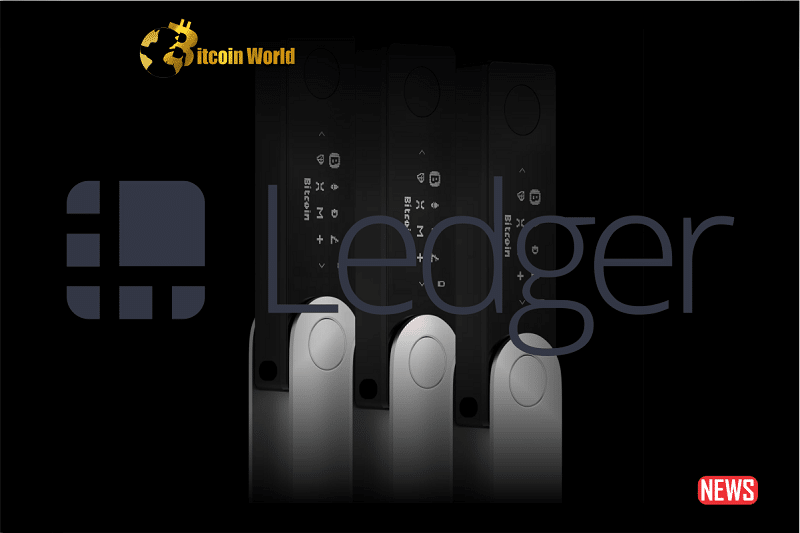The world of crypto can feel like a constant balancing act, especially when it comes to securing your digital assets. Recently, Ledger, a big name in hardware wallets, found itself in the eye of a storm. Their proposed firmware update for the Nano X aimed to make recovering your precious private keys easier. Sounds helpful, right? Well, the Web3 community had other ideas, and their reaction was swift and decisive.
The Update That Shook the Crypto World
Ledger’s intention was to simplify self-custody, a core principle in the crypto space where individuals control their own private keys. The proposed “Ledger Recover” feature would back up your seed phrase, the master key to your crypto kingdom, by splitting it into three encrypted parts and distributing them across three different platforms. Think of it like having three separate keys to unlock your treasure chest, just in case you lose one.
But this seemingly user-friendly approach hit a major roadblock: the fiercely independent and privacy-conscious Web3 community. Why the uproar?
Why the Backlash? Security vs. Usability
Imagine entrusting the keys to your financial future to a device designed for ultimate security. Hardware wallets, often called cold wallets, are prized for keeping your private keys offline, shielded from the prying eyes of the internet. Ledger’s proposed recovery feature, while aiming for convenience, inadvertently poked holes in this very foundation.
- KYC Concerns: The opt-in recovery service would require users to go through “Know Your Customer” (KYC) procedures. This means handing over your personal identification, creating a potential honeypot for malicious actors. Think of it – now hackers have a centralized target with valuable user data linked to crypto holdings.
- Third-Party Trust: The seed phrase shards were to be distributed across three platforms, some of which weren’t initially disclosed. This lack of transparency left users wondering, “Who are these guardians of my keys, and can I truly trust them?”
- Undermining Core Principles: For many in the Web3 space, self-custody isn’t just about security; it’s about autonomy and control. Entrusting key fragments to third parties felt like a step backward, contradicting the very ethos of decentralization.

The Quick Reversal and the Promise of Open Source
Ledger initially defended their decision, but the overwhelming negative feedback from the Web3 community couldn’t be ignored. In a significant move, Ledger backtracked on the controversial update and, more importantly, committed to open-sourcing more of their codebase. This includes the core operating system and, yes, even the Ledger Recover update itself.
This commitment to transparency is a significant step towards rebuilding trust. Open-sourcing allows the community to scrutinize the code, identify potential vulnerabilities, and contribute to its security. It’s like inviting the entire neighborhood to inspect the locks on your door, ensuring they are as robust as possible.
The Lingering Concerns: Single Point of Failure
Even with the move towards open source, a fundamental question remains: does the Recovery feature address the inherent single point of failure in traditional hardware wallets?
While the recovery mechanism offers a backup, the private key itself is still a single entity. Distributing shards for recovery doesn’t eliminate the risk associated with the generation and initial storage of that single key. Think of it like having multiple copies of a fragile document – the original is still vulnerable.
Is There a Better Way? Enter Multi-Party Computation (MPC) Wallets
Ledger’s experience highlights the ongoing quest for the perfect balance between security and user experience. So, what are the alternatives? Multi-party computation (MPC) wallets are emerging as a promising solution.
MPC Wallets: A Potential Game Changer
MPC wallets take a different approach to key management. Instead of generating a single private key, they utilize cryptographic protocols to generate encrypted key shards for multiple parties. Here’s why they’re gaining traction:
- Eliminating Single Point of Failure: No single entity holds the complete private key. This significantly reduces the risk of compromise.
- Enhanced Security: Even if one shard is compromised, the attacker cannot access the funds without the other shards.
- Simplified User Experience: MPC protocols can streamline transactions and key management, making them more user-friendly.
- Cross-Wallet Compatibility: Many MPC solutions prioritize interoperability, allowing seamless interaction with different blockchain networks and wallets.
Of course, MPC wallets aren’t without their challenges:
| Challenge | Considerations |
|---|---|
| Performance Requirements | MPC computations can be resource-intensive, potentially impacting transaction speed. |
| Network Inefficiencies | Communication between multiple parties can introduce latency. |
| Complexity | The underlying cryptography can be complex, requiring specialized expertise. |
Key Takeaways and the Power of the Web3 Community
Ledger’s recent experience serves as a valuable lesson for the entire Web3 space:
- Security First: In the world of crypto, security should always be the top priority. Convenience shouldn’t come at the expense of fundamental security principles.
- Transparency is Crucial: The Web3 community values openness and transparency. Clear communication and open-source initiatives are vital for building trust.
- Community Matters: The swift and unified response from the Web3 community demonstrates its power and influence. Ignoring community sentiment can have significant consequences.
- Innovation in Security: The emergence of MPC wallets highlights the ongoing innovation in crypto security, offering potential solutions to existing challenges.
The Road Ahead
Ledger’s commitment to open-sourcing its technology is a positive step. The community will be watching closely to see how this unfolds and how Ledger navigates the delicate balance between security and user experience moving forward. The incident underscores the core values of the Web3 movement: decentralization, collaboration, and a relentless pursuit of secure and user-centric solutions. The conversation about how best to secure our digital future is far from over, and the Web3 community will undoubtedly continue to play a pivotal role in shaping its direction.
Disclaimer: The information provided is not trading advice, Bitcoinworld.co.in holds no liability for any investments made based on the information provided on this page. We strongly recommend independent research and/or consultation with a qualified professional before making any investment decisions.


